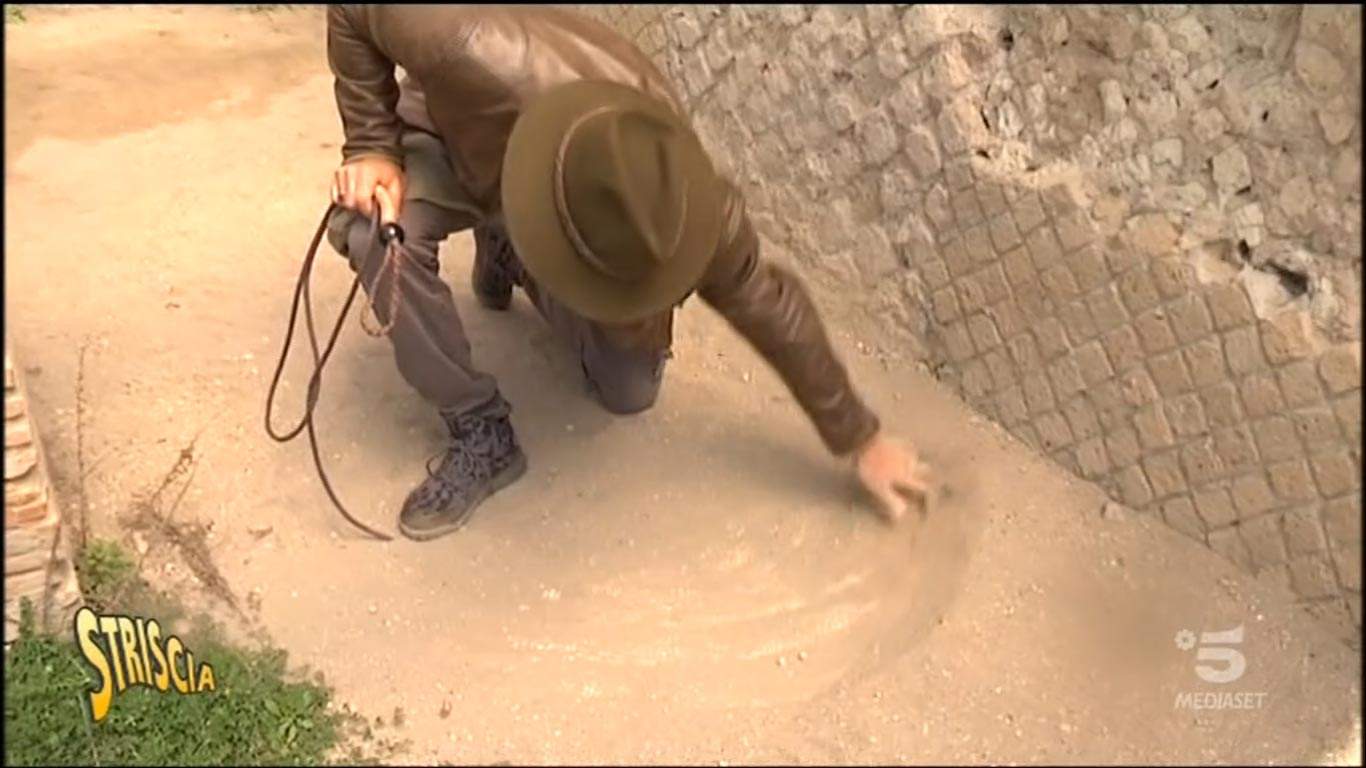The National Etruscan Museum of Villa Giulia reprimands the popular television program Striscia la notizia for a report aired in the evening of April 20, dedicated to the degradation in which part of the Veio Archaeological Park is in (absence of illustrative panels, weeds, rusty gates, partially broken canopies). In the report, Striscia’s correspondent Jimmy Ghione, disguised as Indiana Jones to stage the character of “Indiana Ghions,” went to Veio to denounce the state in which a part of the archaeological site is located: at one point, however, Ghione can be seen starting to remove handfuls of soil from some of the mosaics in the bath complex, misunderstanding the purpose of those layers of sand, purposely left by archaeologists on the mosaics to protect them from the weather, and not accumulated due to neglect. The Museum, while appreciating the idea of bringing the issue of Veio’s enhancement to the attention of Channel 5’s large audience, especially at a time when the forced closure of cultural sites risks causing culture itself to be forgotten or overshadowed, could not help but denounce the correspondent’s conduct.
Penetrating closed and fenced archaeological areas without permission from the Superintendence and tampering with archaeological assets (albeit with good intentions), is in fact a crime and “puts at risk precisely those testimonies of art and culture that are intended to be appreciated and protected,” the museum points out. “For example, it is not good to remove the layer of earth purposely left by archaeologists to protect a mosaic, unless you intend to restore it.”
Even harsher had been yesterday, with a Facebook post, the director of the National Etruscan Museum, Valentino Nizzo, who had spoken of an “abominable service” where “among the many rubbish (such as defining the tomb of the Roaring Lions as the oldest tomb in Italy, with good peace for those who died before the 7th century BC.C.!), dwelling on the site of Campetti at Veio he puts on a fine show of removing soil placed specifically on the mosaics so as not to damage them taking it as a sign of neglect. Doing so exposes to further vandalism a site that has already suffered enough. Services such as these instead of having any social utility are likely to result in dangerous boomerangs for protection. The only way to protect our endless heritage is in many cases to cover it up. It is unimaginable to place custodians everywhere h24. No one could support it unless we hire 50 percent of adult Italians for this purpose. Maybe then also demanding that the sites remain open for free. We’re just not there, and it’s really a shame to see such nonsense in prime time at a time when the Superintendency and all the other entities potentially involved are making a superhuman effort to revitalize the Veio site.”
And indeed, the Ministry of Culture is making a superhuman effort to recover and relaunch the urban site of ancient Veio, a vast archaeological and naturalistic site, included in the Veio Park and wedged in the XV Municipality of Roma Capitale, which is often neglected and forgotten by the normal tourist routes. “The uneasy relationship that still characterizes Rome and Veio,” the museum points out, "continues the one that already in antiquity pitted the rival cities on either side of the Tiber and made the Etruscan metropolis the first great adversary to fall under the blows of Roman expansion. Today a recovery of that relationship is finally possible and must be pursued with all available resources. For this reason, already for some months the Ministry of Culture has shared a research, protection and enhancement project with Sapienza University of Rome and the Ente Regionale Parco di Veio, which has been expending commitment and energy for many years to promote the area(www.parcodiveio.it). The title of the project, Veio: Lost City, recalls the legendary aura of a vanished city, to be rediscovered and enhanced and not explored and plundered in the manner of ’treasure seekers.’"
The strategic plan for the redevelopment of the archaeological and natural area of Veio involves the departments of Architecture and Design and Science of Antiquity at theUniversity of Rome La Sapienza, which can provide the expertise needed to plan the plan, as well as the Soprintendenza Archeologia Belle Arti e Paesaggio for the province of Viterbo and l’Etruria Meridionale, competent for the territory, the Directorate of the State Museums of the City of Rome, owner of the sanctuary of Portonaccio, and the National Etruscan Museum of Villa Giulia, where the major archaeological evidence of Veio is exhibited.
“The project interventions,” the museum concludes, "combine the objectives of redevelopment and enhancement with the needs of securing and accessibility of the archaeological areas currently closed to the public. In due course, the local authorities interested in the Veio territory, which extends over several municipalities and reached in antiquity to the right bank of the Tiber, will also be involved in the planning. A first result has already been obtained by the Veio Park, which in agreement with the Superintendence has completed the new edition of the Archaeological Guide to the Park of Veio, which will soon be presented in the National Etruscan Museum of Villa Giulia, thus inaugurating the new season of valorization of the Etruscan and Roman ’disappeared city’."
 |
| Etruscan museum takes on Striscia for report on Veio: no tampering with assets |
Warning: the translation into English of the original Italian article was created using automatic tools. We undertake to review all articles, but we do not guarantee the total absence of inaccuracies in the translation due to the program. You can find the original by clicking on the ITA button. If you find any mistake,please contact us.